Relevant events
Results
- Generalized growth in more recurrent revenue in practically all geographic areas.
- Operating expenses remain under control, leading to an improvement in the efficiency ratio.
- Lower amount of impairment on financial assets not measured at fair value through profit or loss (hereinafter, "impairment losses on financial assets").
- As a result, the net attributable profit was €2,649m, 14.9% higher than the first half of 2017.
Net attributable profit (Million euros)
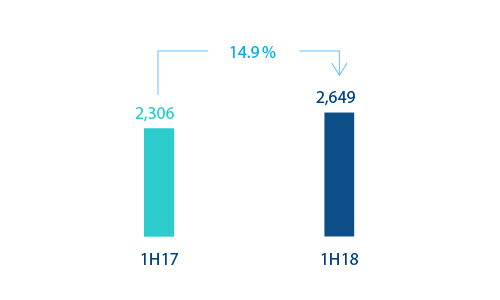
Net attributable profit breakdown (1) (Percentage. 1H 2018)
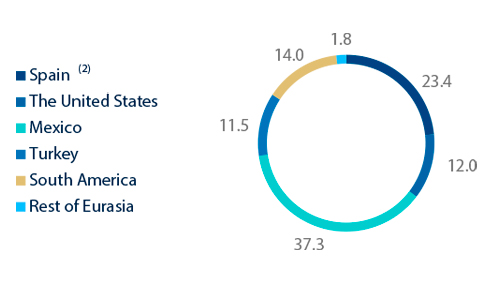
(1) Excludes the Corporate Center.
(2) Includes the areas Banking activity in Spain and Non Core Real Estate.
Balance sheet and business activity
- Loans and advances to customers (gross) increase in emerging geographies and the United States, but decline in Spain.
- Non-performing loans continue to improve.
- Within the off-balance-sheet funds, mutual funds continue to perform positively.
Solvency
- The capital position is above regulatory requirements.
- BBVA has received a communication from the Bank of Spain regarding its minimum requirement for own funds and eligible liabilities (MREL requirement), as determined by the Single Resolution Board (SRB). The Group estimates that it currently meets this MREL requirement.
- Issuance of the so-called green bonds for €1 billion (senior non-preferred debt).
Capital and leverage ratios (Percentage as of 30-06-2018)
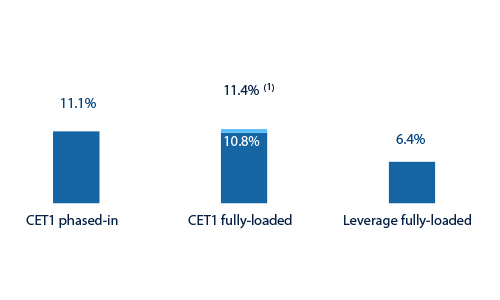
(1) Data pro-forma includes + 55 basis points from announced corporate transactions (sale of real-estate assets to Cerberus and BBVA Chile, closed in July).
Risk management
- Good performance of the main credit-risk metrics over the first six months of the year: as of 30-June-2018, the NPL ratio closed at 4.4%, the NPL coverage ratio at 71% and the cumulative cost of risk at 0.82%.
NPL and NPL coverage ratios (Percentage)
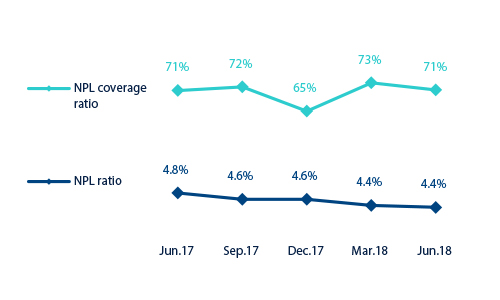
Transformation
- The Group's digital and mobile customer base and digital sales continue to increase in all the geographic areas where BBVA operates.
Digital and mobile customers (Million)
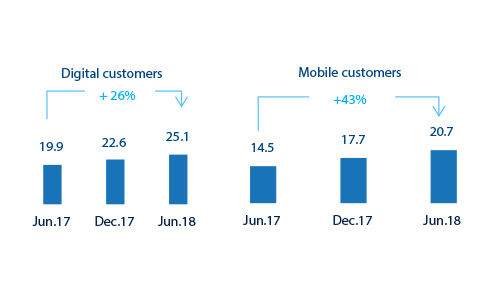
Other matters of interest
- On July 6, BBVA has completed the sale of approximately 68.2% of its stake in BBVA Chile. The impacts of this transaction will be reflected in the Group’s financial statements for the third quarter of 2018.
Impact of the initial implementation of IFRS 9
- The figures corresponding to the first half of 2018 are prepared under International Financial Reporting Standard 9 (IFRS 9), which entered into force on January 1, 2018. This new accounting standard does not require the comparative information from prior periods, so the comparative figures shown for the year 2017 have been prepared in accordance with the IAS 39 (International Accounting Standard 39) regulation in force at that time.
- The impacts derived from the first application of IFRS 9, as of January 1, 2018, have been registered with a charge to reserves of approximately €900m mainly due to the allocation of provisions based on expected losses, compared to the model of losses incurred under the previous IAS 39.
- In capital, the impact derived from the first application of IFRS 9 has been a reduction of 31 basis points with respect to the fully-loaded CET1 ratio of December 2017.
- With respect to the main risk metrics, the exposure to non-performing loans hardly changed, lending fell due to reclassification of portfolios and the NPL coverage ratio rose as a result of the increase in loan-loss provisions.
